
The Grandfather of 35mm Photography
By: Thorsten Overgaard <--- Back to Page 1
The origin of photography [a work in progress]
Pictures are painted by light. If one studies the great painters one will realize that they knew about light, even they didn't know about photography.
Drawing is about seeing and copying that to it is precise and communicates what you saw (with the allowed artistic alteration, as in Pablo Picasso). And apart from the composition, the shapes of bodies and objects, rhythm of movements and repetition, what makes an image is reflections of light.
A note on "reflections of light"
The colors, how alive and sparkling an image is, how sharp ot appears to be, the detilas, the 3D feel og things, what can be seen and what is hidden, all comes from reflections of light.
In my extension course I have an assignment about reflections of light, and what I usually get back is images of a light source reflecting in water, glass or or other direct reflection of the light source.
But if you notice, most great paintings or great photography doesn't have the sun as a direct element in them. Only the reflections defining the shapes, surfaces, colors, details, etc, as in this exampe of Danish painter Anna Anchers 1883-painting The Girl in the Kitchen:
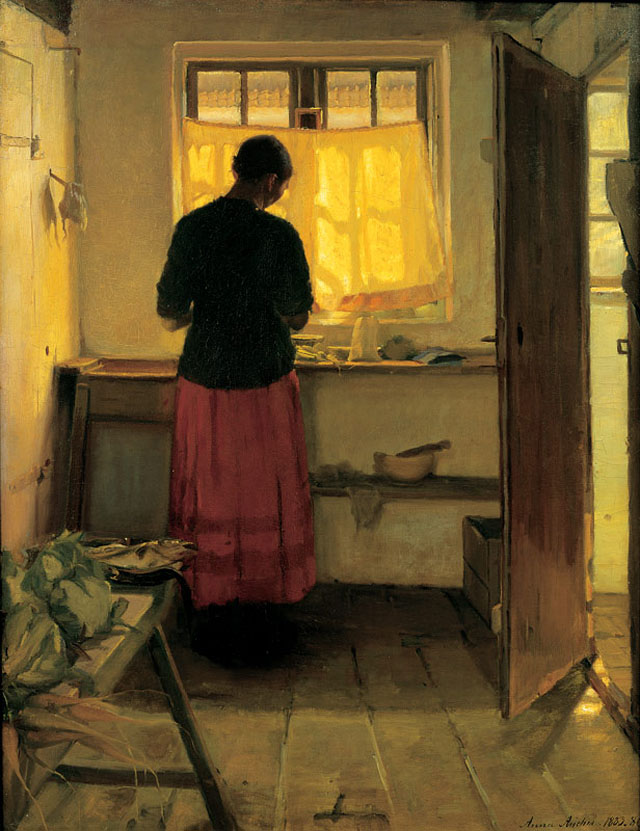
Anna Ancher: The Girl in the Kitchen. Denmark 1883-86. Oil paint 87,7 x 68,5 cm. Owned by The Heinrich Hirschsprung Collection, Copenhagen
See how reflections of light create the shades on the floor, of the cloth hanging on the wall, how your eye is directed by highlighs and shadow and how the reflections of light defines and makes every detail in the image look beautiful.
Another example with more sunlight and almost direct sunlight:
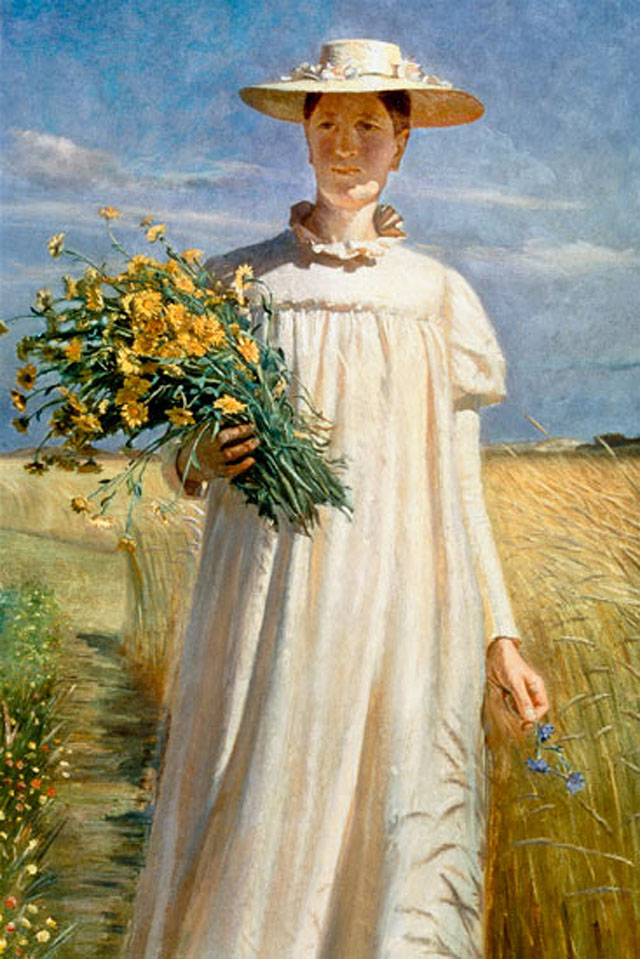
You are going to love this detail: Anna Ancher, painted by her husband Michael Peter Ancher in the "Anna Ancher returning from Flower Picking". They both lived in Skagen in the upper north of Denmark
where the light was particular nice because of the surrounding sea and where a lot of Danish painters, writers and bohemes moved to in the summer time and where the golden agen of Danish painting origins.
In the above image it is even easier to see how reflections of light is what creates the aesthetics. Because this one has both the harsh sunlight on the field behind and at part of the model, as well as the shadow area in the face and part of the body where only reflections of light defines the image.
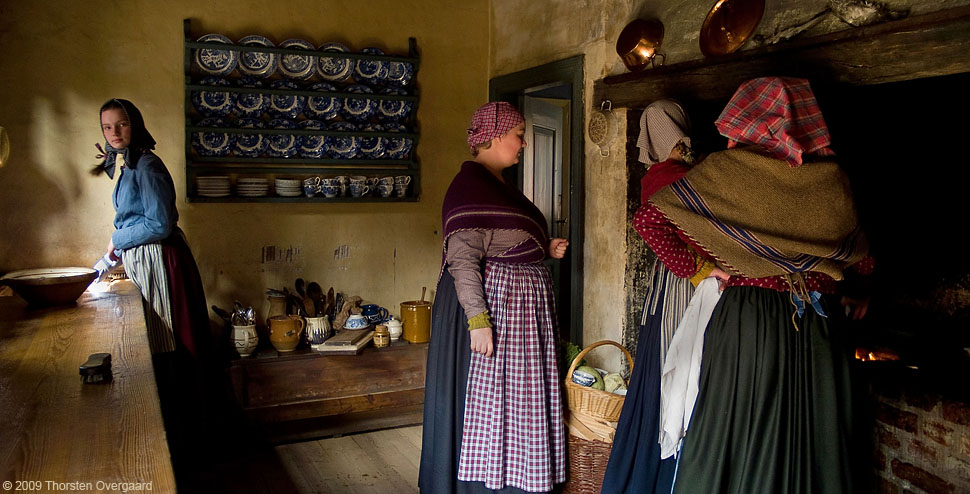
The same time eperiod as a picture. The Old Town in Aarhus, Denmark 2009. This is a museum with living actors acting in the time period with original dresses, in original houses and everything from that time period.
In the above picture you see how reflections of light, and not a direct light source, is what creates the apparanet sharpness, the level of details, colors and basically the whole aesthetics of the picture.
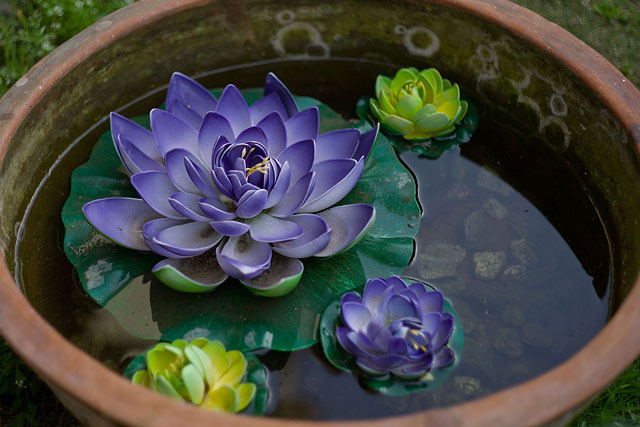
You see - no light source, only reflections of light defining shapes, colors, details and all. You could probably think of many other types of light that would make this less pleasant to look at...
Quality of light
The idea most people have that sunshine is great for photogrsaphy, is wrong. As can be seen in the above pictures it's not the sunshine, but the reflections of light that creates the image.
Quality of light is defined as the size of the light source, not how strong it is. That is why early morning light and late afternoon light is intersting for a photographer; because the light reflects from buildings, walls, shop windows and other. And if you place a model next to a big building that reflects the sunlight, you get a light source the size of that building. And if the light is low, the light bounces from that building to another, to the windows, and suddenly you have a model covered in quality light from several large light source. Hence you have good light!.
London is often a great place to photograph. For once it has lots of different styles, intersting people, iconic buildings, lamps, taxis and other that make an image intersting. But the size of the streets, the not too tall buildings, the shop windows, the often wet streets all create some nice reflections. Different from for example New York where you have tall skyscrabers on Manhattan. And different from Berlin where you have broad boulevards with few large buildings.
Advertisement:

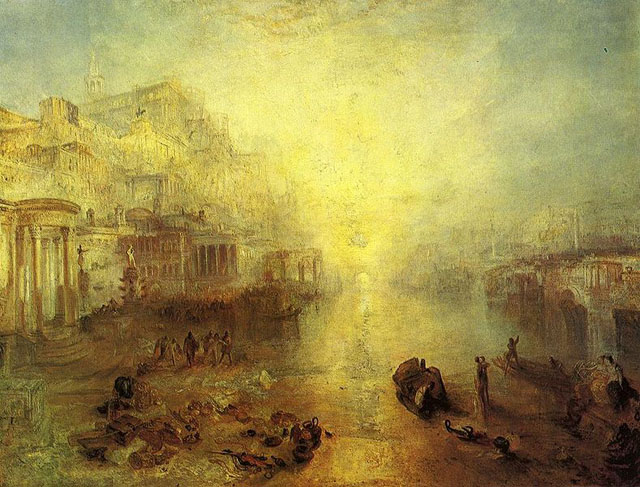
The British painter JMW Turner (1775-1851) was known as as "the painter of light" and died just about the same time as worlds first recordings of light by the use of optics and chemicals happened.
You could then argue that Williamsburg in New York has some similarities to London, and it does. And you could also find areas in Berlin where the size and shape of things would be the same. But London has one more interesting feature, which is the weather!
Often there is a layer of clouds above London that covers for the sun and make that misty formation of clouds into one big silk screen. And even when the sun is shining bright over London and it is not raining, the clarity of light is different than say Berlin and New York - most likely because Uk is surrounded by water, the level of pollution or other.

Soho, London. Leica M9 with 35mm Summilux-M ASPH f/1.4. Photo: Thorsten Overgaard.
Time line of artists using pre-photographic principles
From as early as 500 years Before Christ scientists, pohilosophers and painters knew about the principes that would lead to the actual recording of an image 2,300 years later. Here is first a time line of their work to understand and unse these principles that lead the artists to use pinholes, camera obscures and camera lucida to help the astronoms understand the universe and the artists make more precise drawings.
Year 300-500 Before Christ: Chinese and Greek philosophers describe the basic principles of optics and the camera:
The first surviving mention of the principles behind the pinhole camera, a precursor to the camera obscura, belongs to Mo-Ti (470 BC to 390 BC), a Chinese philosopher. Mo-Ti referred to this camera as a "collecting plate" or "locked treasure room".
Greek philosopher Aristotle (384 to 322 BC) understood the optical principle of the pinhole camera. He viewed the crescent shape of a partially eclipsed sun projected on the ground through the holes in a sieve, and the gaps between leaves of a plane tree and noted "sunlight travelling through small openings between the leaves of a tree, the holes of a sieve, the openings wickerwork, and even interlaced fingers will create circular patches of light on the ground."
The Greek mathematician Euclid of Alexandria's "Optics" (ca 300 BC), presupposed the camera obscura as a demonstration that light travels in straight lines.[5]
600: The greek architect Anthemius of Tralles (474-558) used a type of camera obscura in his experiments.
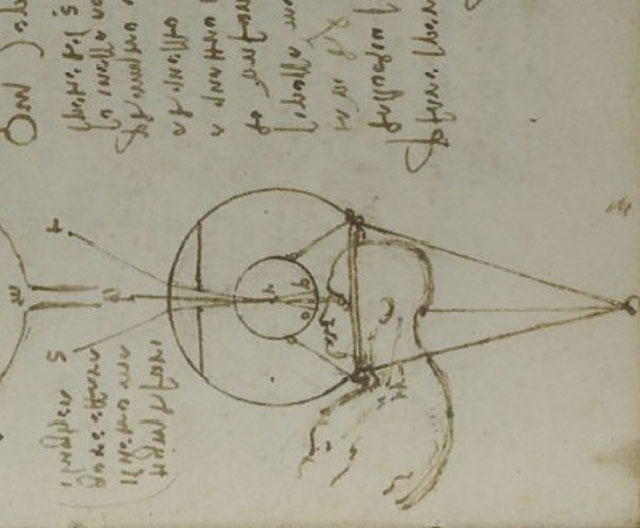
A drawing by Leonardo da Vinci from his manuscript D (1508)
1508: Leonardo da Vinci (1452–1519) described the principles of camera obscura in Codex Atlanticus.
1544: The first drawing of a pinhole camera or camera obscura by Dutch physician and astronomer Gemma Frisus (1508-1555) . He used the pinhole in his darkened room to study the solar eclipse of 1544.
1558: Giovanni Battista della Porta (1535–1615), writing in his 'Magia Naturalis' (Natural Magic, 1558), suggested using a camera obscura as an aid to drawing.
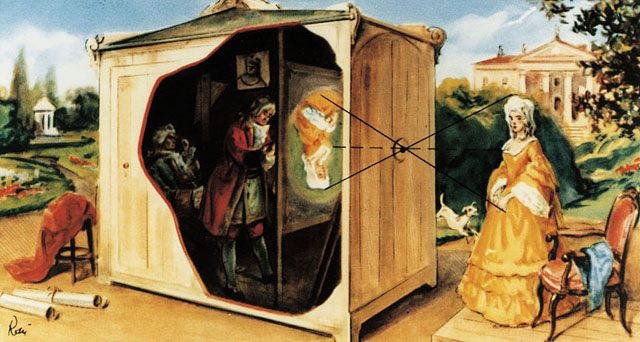
1604: The term "camera obscura" was first used by the German astronomer and mathematician Johannes Kepler (1571-1630) who used a darkened tent. Kepler paused his other work the year before to focus on optical theory. The resulting manuscript, presented to the emperor on January 1, 1604, was published as 'Astronomiae Pars Optica' (The Optical Part of Astronomy). Kepler described the inverse-square law governing the intensity of light, reflection by flat and curved mirrors, and principles of pinhole cameras, as well as the astronomical implications of optics such. He also extended his study of optics to the human eye, and is generally considered by neuroscientists to be the first to recognize that images are projected inverted and reversed by the eye's lens onto the retina.
He said, "...how that representation or that painting is linked with the visual spirits who have their seat in the retina and the nerve
... I will leave to the Physicists to discuss.
1650: Dutch painter such as Johannes Vermee (1632-1675)r, were known for attention to detail. It has been widely speculated that they made use of a camera obscura. In the movie "The Girl with the Peral Earring" with Charlotte Johansson one can see how Vermeer uses the camera).
1664-1666: Isaac Newton discovers that white light is composed of different colors.
| |
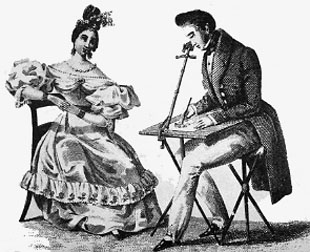 |
| |
1807: Camera Lucida ("light room" from Latin) |
1685: Johann Zahn's (1641 - 1707) 'Oculus Artificialis Teledioptricus Sive Telescopium' was published and contains many descriptions and diagrams, illustrations and sketches of both the camera obscura and of 'the magic lantern' (an early projector or enlarger).
1727: Johann Heinrich Schulze discovered that silver nitrate darkened upon exposure to light.
1794: First Panorama opens, the forerunner of the movie house invented by Robert Barker.
1807: Camera Lucida ("light room" from Latin) was patented by William Hyde Wollaston. A much more compact drawing device than the camera obscura as in this you just looked through a lens and could see your drawing paper with a reflection of the subject (by the help of a mirror-glass or prism close to the eye you compare your drawing to the subject).
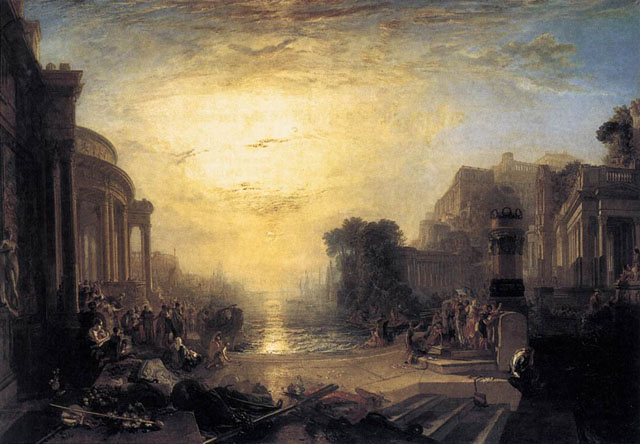
JMW Turner (1775-1851)
Photography time line
We already record mental image pictures by nature, but mankind seem to have been more or less obsessed with recording images (drawings and paintings) throughout history. Whenever something happened, we wanted a recording of it other than the one we have in our mind. Some times to imrove onthe artistic presentation of reality, at other times to be able to share, and some times just to make sure we wouldn't forget.
With the attention devoted to the subjecs involved in photography that had been going on for 2,300 years, someone one day had to follow the urge to instantly record images precisely without having to draw or paint it. And someone did in 1814 with chemistry (Joseph Niepce), in 1884 George Eastman imporoves it with flexible, paper-based photographic film, and in 1948 another again as absolutely instant images (Dr Land with his Polaroid), and then digitally in 1975 where Steve Sasson built the worlds first 0.01 megapixel camera.
This is the story of Photography as it unfolds itself over the last 200 years:
1814: Joseph Niepce achieves first photographic image with Camera Obscura - however, the image required eight hours of light exposure and later faded.
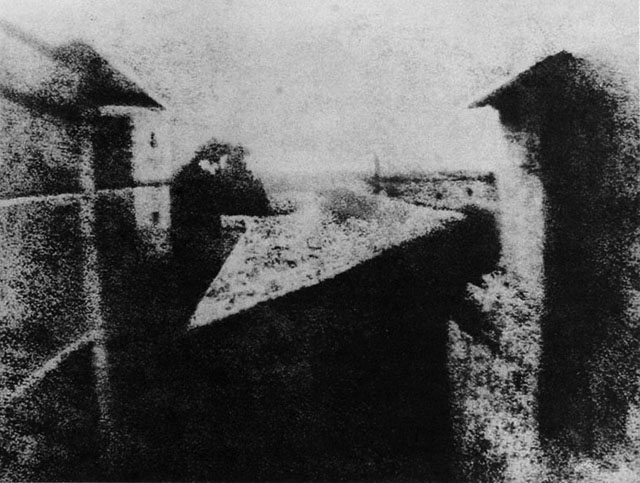
The worlds first photograph that still exists. Louis Daguerre (Louis Jacques Mande Daguerre, 1789-1851) was born near Paris, France. A professional scene painter for the opera with an interest in lighting effects, Daguerre began experimenting with the effects of light upon translucent paintings in the 1820ies.
1837: Louis Daguerre's first daguerreotype - the first image that was fixed and did not fade. It needed 'only' under thirty minutes of light exposure.
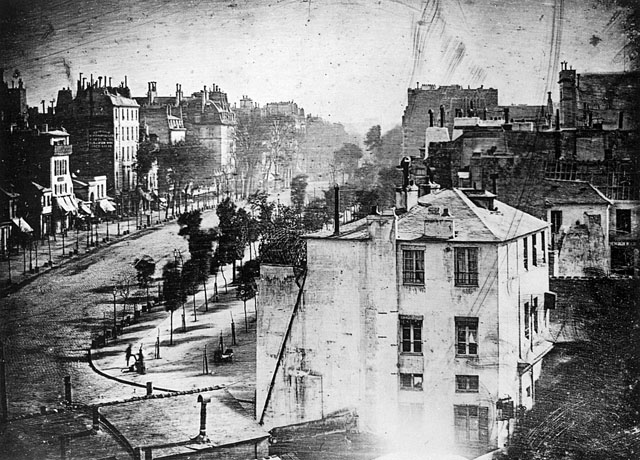
One year later he had improved greatly: 1838 Daguerreotype taken by Louis Daguerre, Boulevard du Temple, Paris.
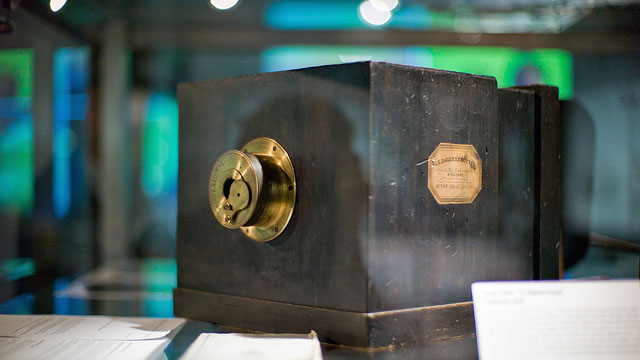
The very first commercially produced Daguerre-type camera from 1839 with just the essential that is needed in a camera. This is the only existing Daguerre-type camera and is on display in the Leica Shop in Vienna, also known as the Westlicht Gallery.
| |
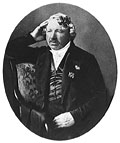 |
| |
Daugerre self portrait 1848 |
Nobody knows how many there was made, this sample is the only existing and they didn't use serial numbers. It was sold to Westlicht for 732,000 Euro in 2010 by a private owner who didn't know what it was. He had received it as a gift in the 1970s from his father after receiving his diploma as an optician.
The artist, scene-painter and physicist Louis-Jacques-Mandé Daguerre (1787-1851) and Joseph-Nicéphore Niépce never had exclusive rights to the process he invented, instead receiving a pension for himself and the heir of his former partner Nicephore Niepce from the French state, which declared photography a gift to the world.
1840: First American patent issued in photography to Alexander Wolcott for his camera.
1841: William Henry Talbot patents the Calotype process - the first negative-positive process making possible the first multiple copies.
1843: First advertisement with a photograph made in Philadelphia.
1851: Frederick Scott Archer invented the Collodion process - images required only two or three seconds of light exposure.
1859: Panoramic camera patented - the Sutton.
1859: Oliver Wendell Holmes, called the camera "The mirror with a memory".
1861: Oliver Wendell Holmes invents stereoscope viewer.
1865: Photographs and photographic negatives are added to protected works under copyright.
1871: Richard Leach Maddox invented the gelatin dry plate silver bromide process - negatives no longer had to be developed immediately.
1880: Eastman Dry Plate Company founded.
1884: George Eastman invents flexible, paper-based photographic film.
1888: Eastman patents Kodak roll-film camera.
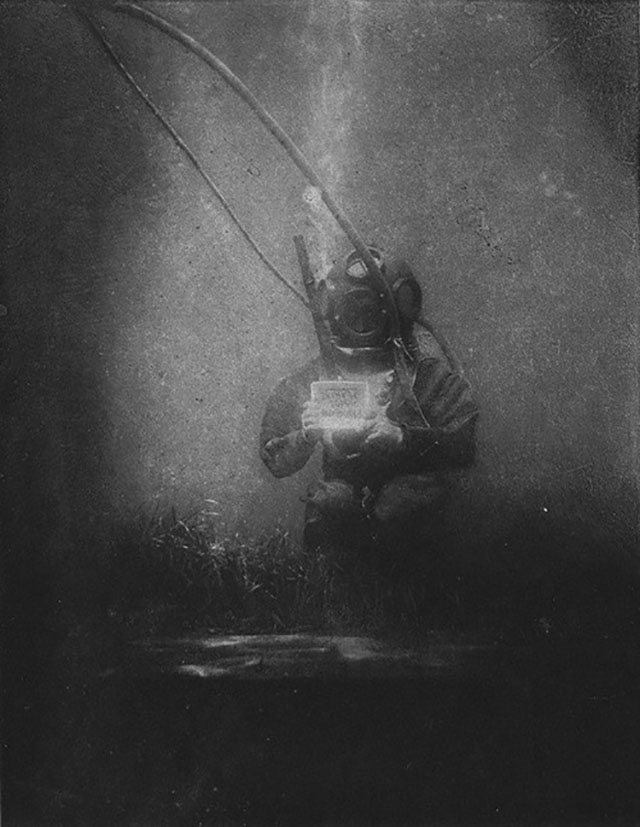
French photographer Louis Boutan and his brother August Boutan were the first underwater photogprahers in 1893.
1893: The worlds first underwater photograher Louis Boutan from France took pictures under water. William Thompson from UK had taken the very first ones in 1856, but that was a camera sent down to the water and remote triggered. Louis and his brother August dived with the cameras.
1898: Reverend Hannibal Goodwin patents celluloid photographic film.
1900: First mass-marketed camera—the Brownie.
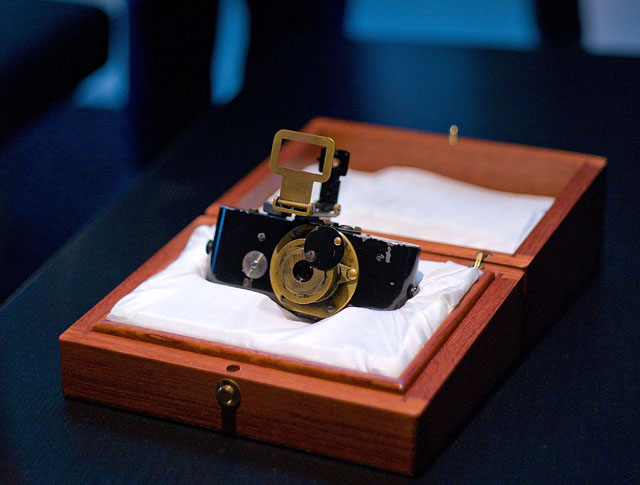
"Barnack's camera," or the Ur-Leica as it is called, anno 1912-1913. It was introduced first time to the market at the 1925 spring fair in Leipzig. The original camera (above) resides in a safe at Leica Camera AG in Solms, Germany. Only two or three of these were made. Photo: Thorsten Overgaard.
1913/1914:
First 35mm still camera developed. One of the early 35mm still camera was the Tourist Multiple from 1914 with standard 35mm film for 750 exposures that utilized the 18x24mm so-called half frame like 35mm motion picture cameras did. Several cameras that were adapted from motion picture photography for still use were also created around the same time. However, the prototype Ur-Leica (invented by Oskar Barnack while working for Ernst Leitz in Wetzlar, Germany) from 1913 used the standard 24x36mm image size on standard, 35mm film. It was different and it lead to a revolution in camera design.
1925: Leica introduces the first Leica 35mm camera to the market and sell the first batch of 1,000 cameras within a year.
| |

Kodachrome 64 ISO film (1935) |
| |
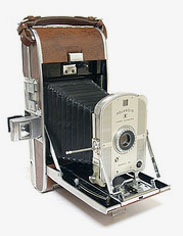
Polaroid Land Model 95 (1948) |
1927: General Electric invents the modern flash bulb.
1931: Eastman Kodak enter the European market. Acquiring the firm of Dr August Nagel in Stuttgart in late 1931, Kodak brought to the market its own 35mm camera, the Retina, and, more importantly, a 35mm daylight-loading single-use cassette.
Both designed by Dr Nagel, the cassette was engineered to be used in Leica and Contax cameras as well as the Kodak Retina and rapidly became the industry standard for all manufacturers of 35mm film.
1932: First light meter with photoelectric cell introduced.
1932: Agfa introduces their revolutionary lenticular colour film in 35mm format.
1935: Zeiss Ikon Contaflex was the first camera with a built-in lightmeter, using a selenium cell.
1935: Eastman Kodak markets their new Kodachrome film firstly in 35mm format.
1937: Leica-photogrpaher Anton Baumann’s book "Das Farbige Leica Buch" was published by Knorr & Hirth in Munchen in 1937, the first book with colour plates engraved directly from 35mm transparencies.
1941: Eastman Kodak introduces Kodacolor negative film.
1942: Chester Carlson receives patent for electric photography (xerography).
1948: Dr. Edwin H. Land markets the Polaroid camera. The Polaroid Corporation was developed and established by Dr. Edwin H. Land in 1937 to manufacture products such as headlights, sunglasses, and camera filters. Along the way Dr. Land invented the Polaroid Land Camera and in 1947 announced his invention of One-Step photography. The Polaroid Land 95 Camera was born and was made from 1948 to 1953.
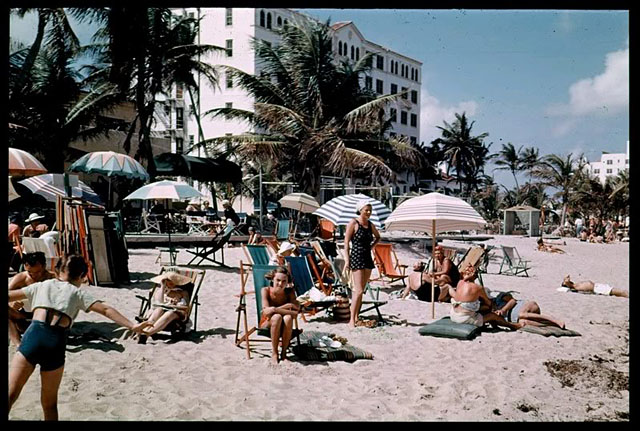
Kodachrome photo from 1936, Miami Beach
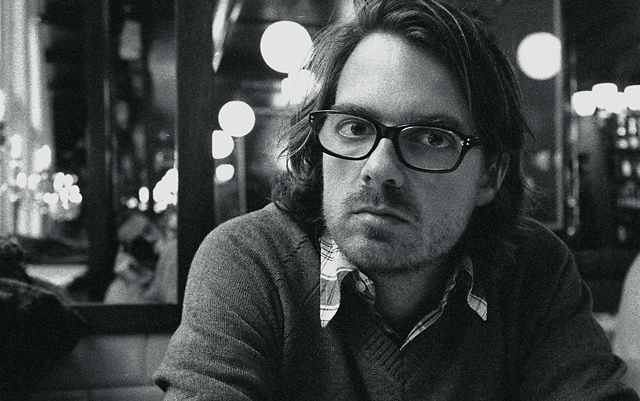 A 2005 photo with Kodak Tri-X 3200 ISO high speed film. Photo: Thorsten Overgaard of Danish designer Claus Due. A 2005 photo with Kodak Tri-X 3200 ISO high speed film. Photo: Thorsten Overgaard of Danish designer Claus Due.
1954: Eastman Kodak introduces high speed Kodak Tri-X film.
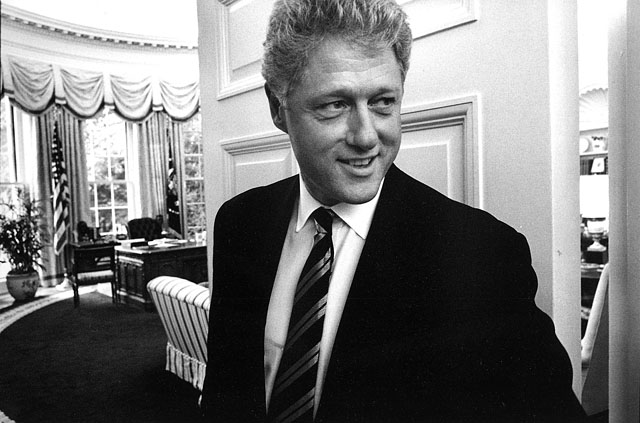
A photo with Kodak Tri-X high speed film and Leica M6 by Robert McNeely. Title: “Bill Clinton in the Oval Office” from the book "The Clinton Years." Up till President Obama most presidential photographers in the White House have been using Leica M cameras, and from 1954 and onwards, the Kodak Tri-X film that allowed low light high speed photogtraphy with silent cameras.
1959: Japanese Nikon introduces the Nikon F single lens reflex in June 1959. Since the 30s German camera technology was the dominant force both in 35mm and medium format.
1960: EG&G develops extreme depth underwater camera for U.S. Navy.
1963: Polaroid introduces instant color film.
1968: Photograph of the Earth from the moon.

1971: Polaroid introduced the Big Shot camera designed for portraits only. It was produced 1971-1973 and used here by Andy Warhol.
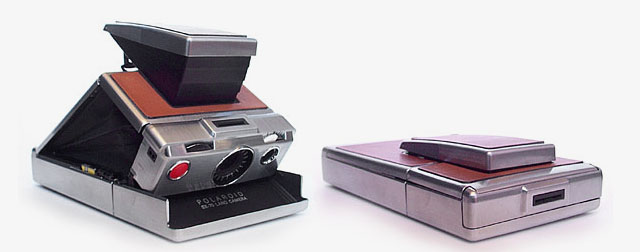
1973: Polaroid introduces one-step instant photography with the SX-70 camera that could be folded.
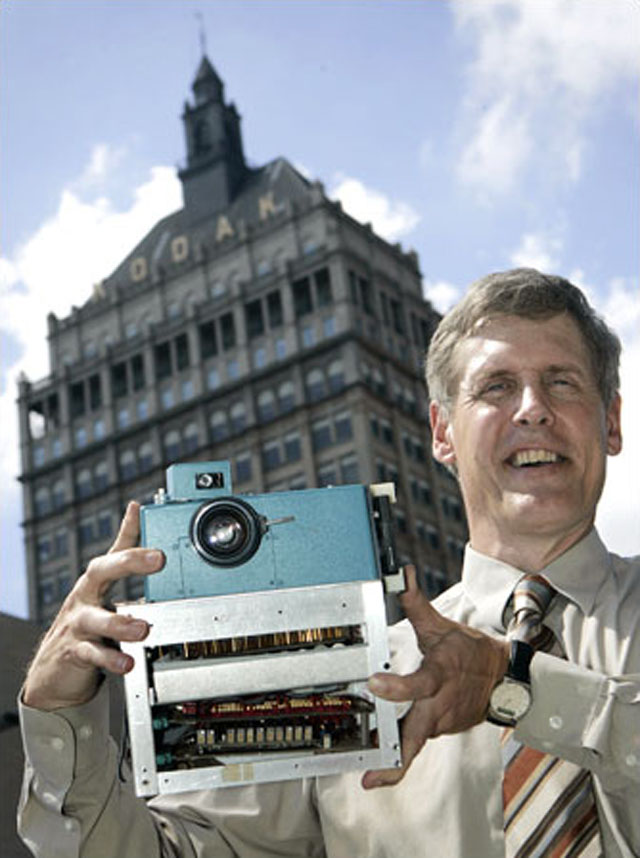
1975: Steve Sasson (1950-), engineer at Eastman Kodak built the first prototype digital camerafrom various camera bits. The camera weighed 8 pounds, recorded black and white images on a cassette tape, had a resolution of 0.01 megapixel (10,000 pixels), and took 23 seconds to capture its first image on a Fairchild 100 x 100 pixel CCD. By 1986 Kodak had developed a sensor with 1.4 megapixels.Steve Sasson was awarded the National Medal of Technology and Innovation model of President Obama in Sepember 2009, the highest honor awarded engineers and inventors.
1976: Leica Camera AG presented auto-focus at Photokina. They had taken out patents on different systems of auto-focus between 1960 and 1973. After Photokina in 1978 where they had presented more AF systems they decided people wanted to focus them self and gave up the systems.
1977: George Eastman and Edwin Land inducted into the National Inventors Hall of Fame.
1978: Konica introduces first point-and-shoot, autofocus camera.
1980: Sony demonstrates first consumer camcorder.
1984: Canon demonstrates first digital electronic still camera.
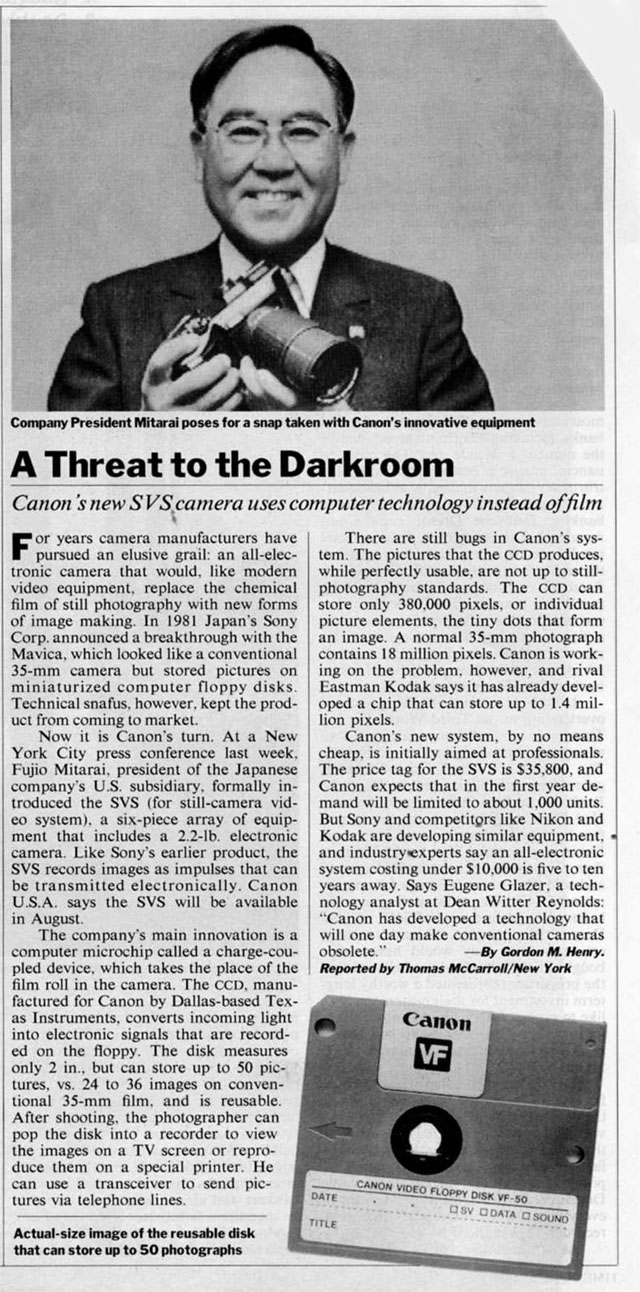
"A Threat to the Darkroom" article in TIME, June 1986. A new $35,800 camera will maek it able for for people to store 59 images on a disk, show them on a television ... and send pictures via telephone lines!
1985: Pixar introduces digital imaging processor.
1990: Eastman Kodak announces Photo CD as a digital image storage medium.
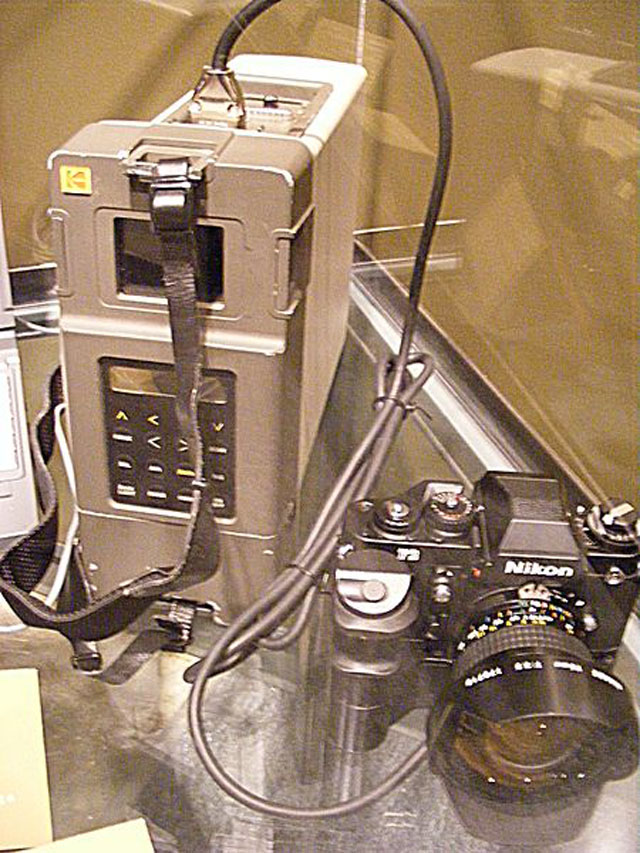
1991: The first commercially available digital camera was the Kodak DCS-100 which had a 1.3 megapixel sensor and cost around $ 13,000 when it was released in May 1991 after that Kodak had shown it at Photokina in September 1990. DCS stood for Digital Camera System and it came with a separate shoulder carried Digital Storage Unit (DSU) to store and to visualize the images, and to house the batteries. It was housed on a Nikon F3 camera body and was aimed at photojournalsts.
1992: The DCS 200 seriescondensed the storage unit into a module which mounted onto the base and back of a stock Nikon F90 SLR. The module contained a built-in 80 megabyte hard drive and was powered with AA batteries.
1994: Kodak DCS 420 (1.5 megapixe, also sold by the Associated Press as the 'Associated Press NC2000') and DCS 460 (6 megapixel, $ 28,000, with the award-winning APS-H Kodak M6 sensor) cameras replaced the hard drive with a PCMCIA card slot. These early models did not include LCD preview screens (except the original DCS-100).
1995: Canon EOS-1, Canon EOS-3 and Canon EOS-5 were Kodak EOS DCS series rebranded as Canon models.
| |
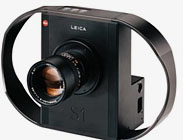 |
| |
Leica S1 75 MP camera (1996) |
1996: Leica Camera AG brought its Leica S1 digital camera to the market. The biggest of the three versions (Pro, Alpha and Highspeed) packed 75 megapixels – many times the resolution other digital cameras of the day. It was aimed at the advertising photography market as a studio camera that delivered a digital scan (30-60 seconds) directly to an Apple computer (using Silverfast software). The price was about $30,000 and 146 was made of them. The S1 took Leica R and M lenses, as well as Hasselblad, Nikon, Canon, Minolta, Zeiss, Olympus, Pentax, Sinar and Mamiya.
(1995: The year before Leica S1 Kodak had introduced DCS Pro 465, a 6 megapixel digital camera back for several medium format cameras like Hasselblad 500 / 503, Mamiya RB / RZ and Sinar cameras)
2002: Full-frame Kodak DCS Pro 14n, Nikon F80 based body. Kodak DCS Pro 14nx variant incorporates updated sensor, memory buffer and firmware from DCS Pro SLR/n.
2009: The Impossible Project acquired 8x10 production equipment from Polaroid in 2009, with plans to produce 8x10 instant film. In March 2010, black and white film started being sold and in August 2010, color film was offered for sale.
To be continued ...
Feel free to e-mail to thorsten@overgaard.dk for advice, ideas or improvements.
|
![]()
